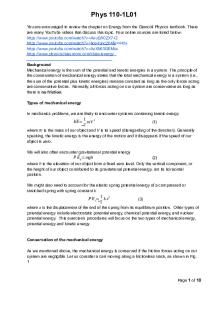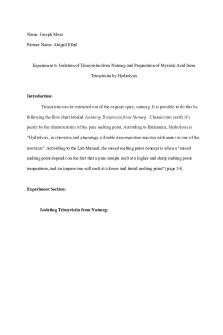Lab 5 - Lab report PDF

| Title | Lab 5 - Lab report |
|---|---|
| Author | zerp zhe |
| Course | Classical Physics Laboratory I |
| Institution | Stony Brook University |
| Pages | 6 |
| File Size | 366.7 KB |
| File Type | |
| Total Downloads | 8 |
| Total Views | 170 |
Summary
Lab report...
Description
Zuha Azam 6/17/2019 PHY 133 Gleb Aminov Lab 5 – Hooke’s Law
Introduction:
In this lab, we will see that the force and distance that is traveled should be proportional by the spring constant. Despite the amount of force, we exert on the device, we should always get the same spring constant. Once we have the spring constant, we can find the potential energy and kinetic energy of the spring and the device while it runs into a vertical barrier. We expect that the spring should conserve most of the impact in order for the kinetic energy before the collision and the kinetic as well as the potential energy after the collision in order for them to be very similar. Hooke’s Law is used whenever there is a spring attached. The extensions can be defined as whenever the spring is stretched. Hooke’s Law says that the force needed to extend or compress a spring by a distance x scales linearly with respect to x. The law can be simplified into the equation Fs = -k∆x. The k is the spring constant. We will use the device to measure its velocity and position while it is attached to the spring, which decompresses and compresses. We need to use the equation −F s =k to find the spring constant of the attached spring. This is basically a rearrangement ∆x of Hooke’s Law. Because the equation is negative, the direction of the force of the spring is always towards the equilibrium point. We use this constant in order to find the potential energy 1 2 of the spring which can be done along with the help of the equation U = k (∆ x ) . 2 Methods/Procedure: Part 1: 1. Make sure that the dongle is connected to your device and the IO Lab device is turned on. 2. Attach the screw to the IO Lab device force probe then attach the long spring to the screw. 3. On a horizontal surface, hold the end that is not attached to the device. 4. Press record and keep recording as the device rolls back and forth. Be mindful as to not to fully compress the spring all the way. 5. Use a parametric plot to find the spring constant. 6. Repeat steps 2 and 3 two more time as we will be taking 3 trials for accuracy. 7. Use all three trials to calculate the mean spring constant and the sigma. Part Two: 1. Remove the large spring and attach the small spring to the force probe. 2. Put the spring along a vertical surface. 3. Press record and keep recording as the spring is slowly compressing and decompressing against the vertical surface. 4. Use a parametric plot to find the spring constant of the small spring. Part Three:
1. With the short spring still attached, record the device as it pushes on a horizontal surface on a fixed vertical surface. 2. Find the velocity and the peak force before and after the collision. 3. Use the peak force and spring constant that we calculated in part 2 to calculate the change in position of the wheels. 4. Find the kinetic energy of the device by using the velocity of the device before the collision along with the mass of the device. 5. Find the kinetic energy of the device after the collision. Results: Figure 1: The graph shows the parametric plot of force versus wheel position during part 1.
Figure 2: The table shows the points used to calculate the slopes of the parametric plots of trials 1-3 in part 1. The slope then gave us the spring constant to find the standard of error. he values in figure 2 were obtained from the parametric plots of Force versus position. The zoom function was used to find the x and y positions during 2 points of the line. I then used the slope equation y2 − y1 =slope , to find the relation between force and position and by using Hooke’s Law x2 − x1 −F s =k , we find that the average spring constant is 13.25 N/m with a standard error of ∆x 0.154. x1
F1
x2
F2
Spring Constant
Trial 1
0.1622
-2.6758
0.2357
-3.6736
13.56
Trial 2 Trial 3 Average
0.1179 0.1422
-2.5678 -2.3963
2.179 0.2513
-3.8801 -3.8235
13.12 13.08 13.25
Standard error
0.154
Figure 3: The parametric plot of force versus device’s wheel position while the device and spring were pressing against a vertical surface.
Figure 4: The graph shows the device’s force versus time during a collision with a vertical surface with the short spring attached.
Figure 5: The above graph shows the device’s velocity versus time during a collision with a vertical surface with the short spring attached.
Calculations:
Discussion/Conclusion: While performing this lab, I gained a better understanding of Hooke’s Law. It was different from other labs as there was a spring involved where we had to be careful not to compress the spring too much and we had to keep it straight along the y axis. The spring constant was very similar throughout all our trials. There is a small standard error. Having the constants being similar throughout all trials is proof that we performed the experiment correctly. There is a small margin of error as is natural because of human error. Again as we perform more trials, we can reduce the amount of error in our experiments. In our results, we found the spring constant to be 181.46 N/m. We used the slope formula to calculate this number. The mass of the device is 0.2 kg which we found prior to performing the spring part of the experiment. The velocity before the peak is -0.43 m/s. The peak force is 2.3 N and the velocity before the peak is 0.32 m/s. We used the spring force and the spring constant 1 2 along with the equation U= k (∆ x ) we found the changing position which is 0.159 m. We 2 use the spring constant and the change in position to find the spring potential energy which is 2.3 N. We found that the kinetic energy before the collision is 0.01849 N and the kinetic energy after 1 2 the collision is 0.01 N. We used the equation KE= m v to find these numbers. 2 The slope of the force vs. position plot was negative due to the force acting in the negative direction while the wheels move away. This can be visualized in Hooke’s Law because it says that the object moves away from the equilibrium point causing the spring to act in a negative direction. The kinetic energy for the before and after collision were not equal. The kinetic energy after the collision is less than the kinetic energy before the collision. The potential energy is higher than that of both kinetic energies....
Similar Free PDFs

LAB 5 - Lab report
- 4 Pages

Lab Report 5 - lab
- 5 Pages

Lab 5 - Lab report
- 6 Pages

Lab 5 - Lab experiment report
- 6 Pages

Lab 5 Lab Report- (Microbiology)
- 4 Pages

Phys lab 5 - Lab report
- 10 Pages

Post Lab Report Lab 5
- 5 Pages

Lab Report 5
- 8 Pages

Lab Report 5
- 16 Pages

Lab 5 Report
- 5 Pages

Chem lab report 5
- 7 Pages

Lab 5 Report
- 8 Pages

EX 5 lab report
- 10 Pages

Lab report 5
- 13 Pages

Lab Report 5
- 6 Pages

Physics lab report 5
- 7 Pages
Popular Institutions
- Tinajero National High School - Annex
- Politeknik Caltex Riau
- Yokohama City University
- SGT University
- University of Al-Qadisiyah
- Divine Word College of Vigan
- Techniek College Rotterdam
- Universidade de Santiago
- Universiti Teknologi MARA Cawangan Johor Kampus Pasir Gudang
- Poltekkes Kemenkes Yogyakarta
- Baguio City National High School
- Colegio san marcos
- preparatoria uno
- Centro de Bachillerato Tecnológico Industrial y de Servicios No. 107
- Dalian Maritime University
- Quang Trung Secondary School
- Colegio Tecnológico en Informática
- Corporación Regional de Educación Superior
- Grupo CEDVA
- Dar Al Uloom University
- Centro de Estudios Preuniversitarios de la Universidad Nacional de Ingeniería
- 上智大学
- Aakash International School, Nuna Majara
- San Felipe Neri Catholic School
- Kang Chiao International School - New Taipei City
- Misamis Occidental National High School
- Institución Educativa Escuela Normal Juan Ladrilleros
- Kolehiyo ng Pantukan
- Batanes State College
- Instituto Continental
- Sekolah Menengah Kejuruan Kesehatan Kaltara (Tarakan)
- Colegio de La Inmaculada Concepcion - Cebu